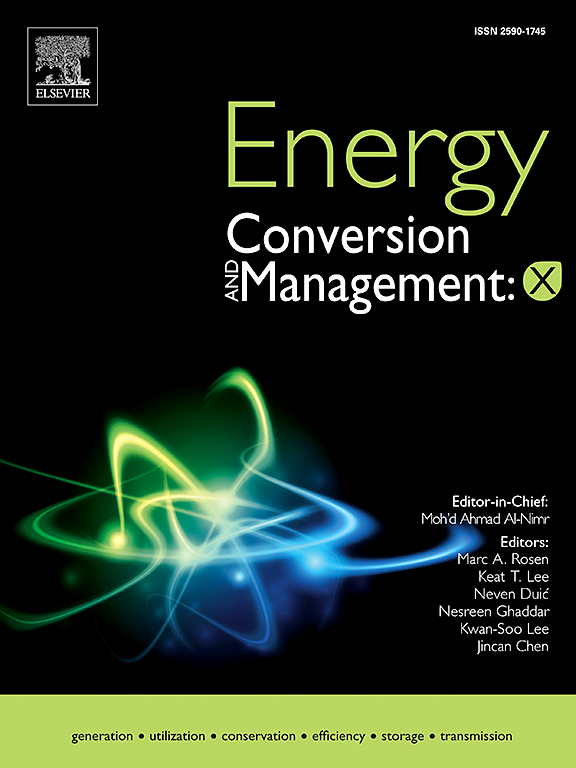The potential of waste heat utilization in solar multistage membrane distillation: An alternative to PV + RO systems?
IF 10.9
1区 工程技术
Q1 ENERGY & FUELS
引用次数: 0
Abstract
Solar membrane distillation (MD) is an emerging technology for addressing water scarcity in arid regions with access to terrestrial water bodies. Recent studies highlight that vaporization enthalpy recycling enhances both distillate flux and solar-to-water efficiency. However, due to high material costs, scaling beyond 10 stages under one-sun solar illumination becomes economically unfeasible. A novel waste heat utilization concept for continuous freshwater production is introduced, supported by a generalized Python-based mathematical model and COMSOL Multiphysics simulations that consider simultaneous heat and moisture transfer. The findings highlight the potential of low-grade waste heat to enhance the efficiency of MD processes. With a solar-to-waste heat ratio of 0.4, a 9-stage MD system can match PV + RO water production per exergy use (36.2 L kWh-1), while even a 3-stage MD system operating solely on waste heat surpasses PV + RO performance. This highlights the importance of cross-sectoral integration, where polygeneration, water, and electricity production play a key role. Techno-economic analysis indicates that such a system in Spain could achieve a 6-year payback period, reinforcing its potential as a competitive alternative to PV + RO for freshwater production. This work contributes to UN Sustainable Development Goals 6 and 7 (SDG-6, SDG-7), promoting clean water, sanitation, and sustainable energy solutions.

太阳能多级膜蒸馏余热利用的潜力:PV + RO系统的替代方案?
太阳膜蒸馏(MD)是一项新兴的技术,用于解决干旱地区的水资源短缺,可以获得陆地水体。最近的研究强调,蒸发焓循环提高了馏分通量和太阳能-水效率。然而,由于材料成本高,在一个太阳照明下扩展到超过10个阶段在经济上是不可行的。在基于python的广义数学模型和COMSOL Multiphysics模拟的支持下,引入了一种用于连续淡水生产的新型废热利用概念,该模型考虑了同时的热量和水分传递。研究结果强调了低品位废热提高MD工艺效率的潜力。9级MD系统的太阳能-废热比为0.4,可以匹配PV + RO每次使用的产水量(36.2升千瓦时-1),而即使是仅依靠废热运行的3级MD系统也超过PV + RO的性能。这凸显了跨部门一体化的重要性,其中多联产、水和电生产发挥着关键作用。技术经济分析表明,西班牙的这种系统可以实现6年的投资回收期,从而增强了其作为淡水生产光伏+ RO的竞争性替代方案的潜力。这项工作有助于实现联合国可持续发展目标6和7(可持续发展目标6和7),促进清洁水、卫生设施和可持续能源解决方案。
本文章由计算机程序翻译,如有差异,请以英文原文为准。
求助全文
约1分钟内获得全文
求助全文
来源期刊

Energy Conversion and Management
工程技术-力学
CiteScore
19.00
自引率
11.50%
发文量
1304
审稿时长
17 days
期刊介绍:
The journal Energy Conversion and Management provides a forum for publishing original contributions and comprehensive technical review articles of interdisciplinary and original research on all important energy topics.
The topics considered include energy generation, utilization, conversion, storage, transmission, conservation, management and sustainability. These topics typically involve various types of energy such as mechanical, thermal, nuclear, chemical, electromagnetic, magnetic and electric. These energy types cover all known energy resources, including renewable resources (e.g., solar, bio, hydro, wind, geothermal and ocean energy), fossil fuels and nuclear resources.
 求助内容:
求助内容: 应助结果提醒方式:
应助结果提醒方式:


